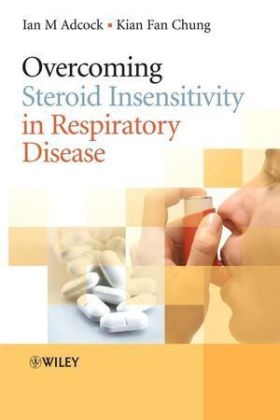
Overcoming Steroid Insensitivity in Respiratory Disease
John Wiley & Sons Inc (Verlag)
978-0-470-05808-4 (ISBN)
- Titel z.Zt. nicht lieferbar
- Versandkostenfrei
- Auch auf Rechnung
- Artikel merken
Written by well-known experts in field, this is the first book dedicated to dealing with the single most challenging management issue in long-term steroid therapy. Overcoming Steroid Insensitivity in Respiratory Disease reviews important new advances in therapeutics and provides the clinician with the most up to date information on one of the most significant therapeutic challenges to effective management of these diseases. This unique book is an invaluable resource for all postgraduate students and specialist physicians in pulmonology allergy and asthma. It is also of interest for workers in biomedical and pharmaceutical research.
Ian Adcock, Professor of Respiratory Cell and Molecular Biology at the National Heart and Lung Institute, Royal Brompton Campus,?London, UK. K Fan Chung, Professor, Experimental Studies Group, NHLI, Royal Brompton Campus,?London, UK.
Contents List of contributors
Preface
1 Molecular Mechanisms of Glucocorticoid Receptor Action
Pankaj Bhavsar and Ian M. Adcock
1.1 Introduction
1.2 Glucocorticoid receptor
1.3 Gene induction by GR
1.4 GR transactivation and histone acetylation
1.5 Post-translational modifications of GR
1.6 Repression of NF-êB-induced inflammatory gene expression by GR–NF-êB
1.7 GR–NF-êB cross-talk
1.8 Role of HDAC2 in glucocorticoid function
1.9 Overexpression of HDAC2 restores glucocorticoid sensitivity in alveolar macrophages
1.10 Acetylation of hsp90 and regulation of GR function
1.11 Other mechanisms of GR action
1.12 Conclusions
2 Side Effects of Topical and Oral Glucocorticoids
Heike Schäcke, Khusru Asadullah and Wolf-Dietrich Döcke
2.1 Introduction
2.2 Glucocorticoid-induced side effects
2.3 Summary
3 Glucocorticoid Receptor Subtypes and Steroid Sensitivity
Robert H. Oakley and John A. Cidlowski
3.1 Introduction
3.2 Overview of classic GR function
3.3 GR subtypes arising from alternative splicing
3.4 GR subtypes arising from alternative translation initiation
3.5 Conclusions
4 Dissociated Glucocorticoids
Ian M. Adcock
4.1 Introduction
4.2 Asthma and chronic obstructive pulmonary disease are chronic inflammatory diseases of the airways
4.3 Regulation of inflammatory gene expression
4.4 Effects on inflammation
4.5 Mechanisms of glucocorticoid action
4.6 Dissociated glucocorticoids
4.7 GR cross-talk with other nuclear receptors and coactivators
4.8 Overcoming steroid insensitivity
4.9 Glucorticoid-sparing approaches to anti-inflammatory therapy
4.10 Conclusion
5 Generalized Glucocorticoid Insensitivity: Clinical Phenotype and Molecular Mechanisms
Evangelia Charmandari, Tomoshige Kino and George P. Chrousos
5.1 Introduction
5.2 Molecular mechanisms of glucocorticoid resistance
5.3 Conclusions
6 Corticosteroid Responsiveness in Asthma: Clinical Aspects
Kian Fan Chung
6.1 Introduction
6.2 Effects of corticosteroids in asthma
6.3 Definition of corticosteroid insensitivity
6.4 Oral CS responsiveness in asthma
6.5 ICS responsiveness in asthma
6.6 CS responsiveness in severe asthma
6.7 Surrogates for CS responsiveness in asthma
6.8 Pharmacokinetics of systemic CS in severe asthma
6.9 CS responsiveness in cigarette smokers and chronic obstructive pulmonary disease
6.10 Other diseases of CS insensitivity
6.11 Conclusions
7 Glucocorticoid-insensitive Asthma: Molecular Mechanisms
John W. Bloom
7.1 Introduction
7.2 GR abnormalities
7.3 GR nuclear translocation
7.4 Cross-talk with transcription factors
7.5 NF-kB, GR, histones and chromatin remodelling
7.6 Epigenetics and asthma
7.7 Conclusions
8 Cigarette Smoke, Oxidative Stress and Corticosteroid Responsiveness
Irfan Rahman and David Adenuga
8.1 Oxidative stress
8.2 Cigarette smoke/oxidative stress-induced NF-kB-mediated pro-inflammatory gene expression
8.3 Histone acetylation and deacetylation
8.4 Corticosteroids
8.5 Histone deacetylases
8.6 Reversing Glucocorticoids / Corticosteroid resistance
8.7 Conclusion
9 Regulation of Glucocorticoid Sensitivity by Macrophage Migration Inhibitory Factor
Eric F. Morand
9.1 Introduction
9.2 MIF as a pro-inflammatory factor
9.3 Relationship between MIF and glucocorticoids
9.4 Conclusions
10 Steroid-sparing Strategies: Long-acting Inhaled β2 -Agonists
Anna Miller-Larsson and Olof Selroos
10.1 Introduction
10.2 Why and when is a steroid-sparing effect of LABA important in asthma?
10.3 Effects of lower dose ICS/LABA versus a higher dose ICS on lung function, symptoms and use of reliever medication
10.4 Effects of lower dose ICS/LABA versus higher dose ICS on exacerbations
10.5 Protocols with tapering ICS doses with and without LABA while maintaining asthma control
10.6 Reducing ICS doses using an adjustable ICS/LABA dosing regimen
10.7 Reducing ICS doses using Symbicort® maintenance and reliever therapy
10.8 Does enhanced anti-inflammatory efficacy explain steroid-sparing effects in ICS/LABA therapy?
10.9 Possible Mechanisms of Steroid-sparing Effects by Addition of LABA to ICS
11 Steroid-sparing Strategies: Other Combinations
Gaetano Caramori, Kazuhiro Ito and Alberto Papi
11.1 Introduction
11.2 Theophylline as steroid-sparing treatment in asthma and COPD
11.3 Selective inhibitors of PDE4
11.4 Modulators of the synthesis or action of key inflammatory mediators
11.5 Anticholinergics
11.6 Leukotriene synthesis inhibitors and leukotriene receptor antagonists
11.7 Anti-lgE therapy
11.8 Macrolides/ketolides
11.9 TNFá inhibitors
11.10 Conclusions
12 Kinases as Anti-inflammatory Targets for Respiratory Disease
Iain Kilty
12.1 Introduction
12.2 Pharmacological targeting of kinases
12.3 Targeting NF-êB activation
12.4 Targeting the MAPKs
12.5 Targeting PI3K
12.6 Further potential kinase targets
12.7 Conclusions
13 Pharmacokinetic/Pharmacodynamic Factors and Steroid Sensitivity
Gönther Hochhaus
13.1 Introduction
13.2 What factors are important for pulmonary efficacy and safety?
13.3 Pharmacodynamic aspects
13.4 Pharmacokinetic drug properties
13.5 Conclusion
14 Improved Lung Deposition: New Inhaler Devices
Omar S. Usmani
14.1 Introduction
14.2 Historical review of inhaled drug therapy
14.3 Deposition of aerosols within the respiratory tract
14.4 Assessing drug deposition in the lungs
14.5 Aerosol generation devices for inhaled drug therapy
Index
| Erscheint lt. Verlag | 1.4.2008 |
|---|---|
| Verlagsort | New York |
| Sprache | englisch |
| Maße | 175 x 252 mm |
| Gewicht | 667 g |
| Einbandart | gebunden |
| Themenwelt | Medizinische Fachgebiete ► Innere Medizin ► Pneumologie |
| Medizin / Pharmazie ► Medizinische Fachgebiete ► Pharmakologie / Pharmakotherapie | |
| ISBN-10 | 0-470-05808-0 / 0470058080 |
| ISBN-13 | 978-0-470-05808-4 / 9780470058084 |
| Zustand | Neuware |
| Informationen gemäß Produktsicherheitsverordnung (GPSR) | |
| Haben Sie eine Frage zum Produkt? |
aus dem Bereich


